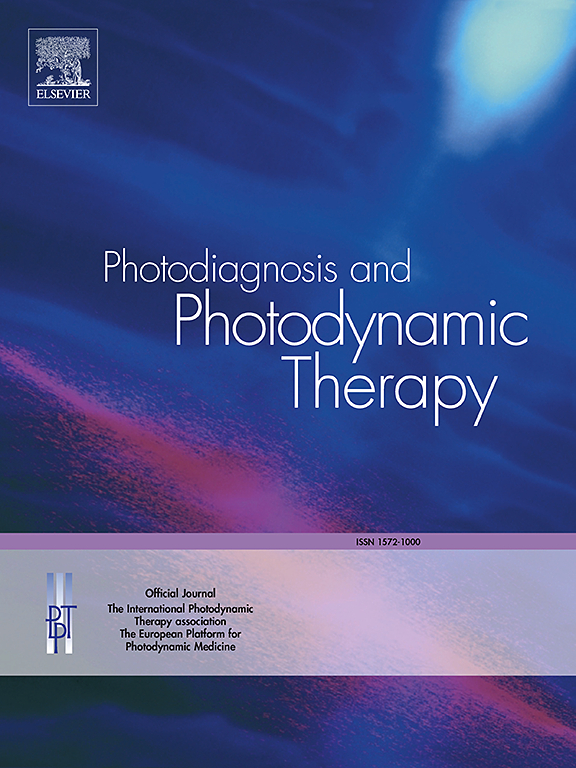5-氨基乙酰丙酸光动力疗法诱导多药耐药毛藓细胞死亡的疗效:体内和体外研究
IF 3.1
3区 医学
Q2 ONCOLOGY
引用次数: 0
摘要
马氏肉芽肿(majorchi 's Granuloma, MG)是一种深度、持续性的化脓性肉芽肿性滤泡周围炎症。MG的传统治疗通常包括全身口服抗真菌药物和局部药物的组合;然而,这种方法往往导致治愈率低,复发率高,不良反应明显。相比之下,5-氨基乙酰丙酸光动力疗法(ALA-PDT)作为一种治疗真菌感染的新策略,正越来越多地用于感染性肉芽肿的治疗。方法1例由蒙氏毛癣菌(T. mentagrophytes)引起的难治性MG患者接受3次ALA-PDT治疗。此外,从患者的病变中分离出一株耐药的mentagrophytes菌株,并在豚鼠模型中进行体外测试和评估,以阐明ALA-PDT对该菌株以及其他临床和标准的mentagrophytes菌株发挥抑制作用的机制。结果经3个疗程的ALA-PDT治疗后,病变完全消除。体外和体内实验均表明,ALA-PDT能显著抑制mentagrophytes的生长。我们进一步证明ALA或ALA- pdt处理可以提高T. mentagrophytes对后续传统抗真菌药物的敏感性。当ALA或ALA- pdt处理时,真菌细胞的结构完整性被直接破坏。这种破坏导致了几个可观察到的影响:细胞壁的完整性受到损害,细胞膜上的毛孔破裂,内质网和线粒体都发生了肿胀。结论ALA-PDT通过增加活性氧(Reactive Oxygen Species, ROS)的释放,破坏了墨氏菌的细胞膜、细胞壁和细胞内部结构,从而促进了真菌的消灭。这项研究强调了ALA-PDT作为一种管理真菌感染的创新策略的治疗潜力,特别是那些对传统治疗有抵抗力的真菌感染。本文章由计算机程序翻译,如有差异,请以英文原文为准。
The efficacy of 5-aminolevulinic acid photodynamic therapy in inducing cell death in multidrug-resistant Trichophyton mentagrophytes: An in vivo and in vitro study
Background
Majocchi’s Granuloma (MG) is manifested as the deep-seated, persistent suppurative granulomatous perifollicular inflammation. Traditional treatment for MG typically involves a combination of systemic oral antifungal drugs and topical medications; however, this approach often results in a low cure rate, high recurrence rate, and significant adverse effects. In contrast, 5-aminolevulinic acid photodynamic therapy (ALA-PDT), which has emerged as a novel strategy for treating fungal infections, is being increasingly utilized in the management of infectious granulomas.
Methods
A patient with refractory MG caused by Trichophyton mentagrophytes (T. mentagrophytes) received three cycles of ALA-PDT. Additionally, a drug-resistant strain of T. mentagrophytes isolated from the patient's lesions was subjected to in vitro testing and evaluated in a guinea pig model to elucidate the mechanisms by which ALA-PDT exerts its inhibitory effects on the strain and other clinical and standard strains of T. mentagrophytes.
Results
After three courses of ALA-PDT, the lesions were successfully eliminated. Both in vitro and in vivo experiments demonstrated that ALA-PDT significantly inhibited the growth of T. mentagrophytes. We further demonstrated that ALA or ALA-PDT treatment could enhance the sensitivity of T. mentagrophytes to subsequent traditional antifungal agent. When T. mentagrophytes was treated with ALA or ALA-PDT, the structural integrity of the fungal cells was directly disrupted. This disruption led to several observable effects: the integrity of the cell wall was compromised, pores rupture in the cell membrane, and swelling occurred in both the endoplasmic reticulum and mitochondria.
Conclusion
These findings suggest that ALA-PDT disrupts the cell membrane, cell wall and internal cellular structure of T. mentagrophytes through increasing the release of Reactive Oxygen Species (ROS), thereby facilitating the elimination of the fungus. This research highlights the therapeutic potential of ALA-PDT as an innovative strategy for managing fungal infections, particularly those resistant to conventional treatments.
求助全文
通过发布文献求助,成功后即可免费获取论文全文。
去求助
来源期刊

Photodiagnosis and Photodynamic Therapy
ONCOLOGY-
CiteScore
5.80
自引率
24.20%
发文量
509
审稿时长
50 days
期刊介绍:
Photodiagnosis and Photodynamic Therapy is an international journal for the dissemination of scientific knowledge and clinical developments of Photodiagnosis and Photodynamic Therapy in all medical specialties. The journal publishes original articles, review articles, case presentations, "how-to-do-it" articles, Letters to the Editor, short communications and relevant images with short descriptions. All submitted material is subject to a strict peer-review process.
 求助内容:
求助内容: 应助结果提醒方式:
应助结果提醒方式:


